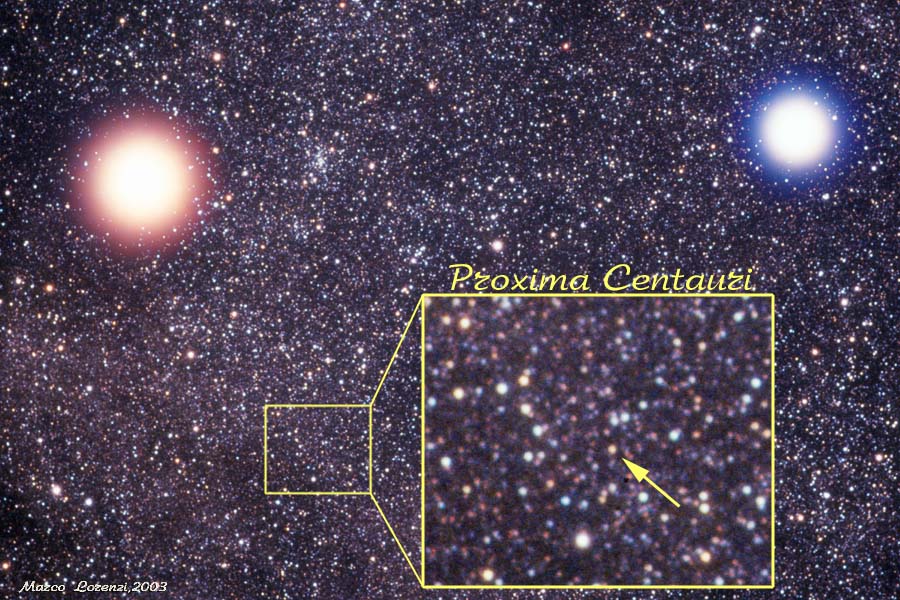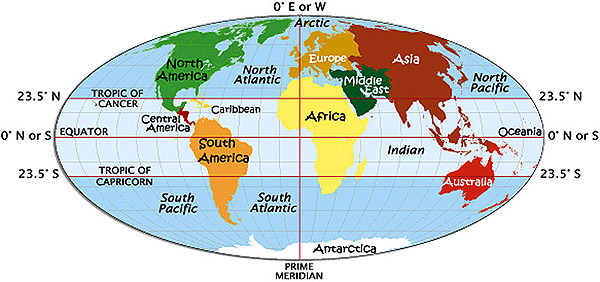Can i watch proxima centuri from anywhere on the earth?
Can i watch proxima centuri from anywhere on the earth?
Can i watch proxima centuri from anywhere on the earth? If no, then why we never mention about the direction while we discuss about celestial bodies? If yes, why so?
- neufer
- Vacationer at Tralfamadore
- Posts: 18805
- Joined: Mon Jan 21, 2008 1:57 pm
- Location: Alexandria, Virginia
Re: Can i watch proxima centuri from anywhere on the earth?
You can see Alpha Centauri if you are south of the Tropic of Cancer but Proxima Centuri is far too faint to see with the naked eye.babaonet wrote:
Can i watch proxima centuri from anywhere on the earth?
http://apod.nasa.gov/apod/ap110703.html
http://asterisk.apod.com/viewtopic.php? ... ri#p151876
Art Neuendorffer
Re: Can i watch proxima centuri from anywhere on the earth?
Proxima Centauri is an eleventh magnitude star, five magnitudes fainter than what can be seen with the naked eye. You would actually need a telescope to see it. Ordinary binoculars aren't enough.

Proxima Centauri is the red star in the center of this image, deep in the rich star fields of Centaurus.
Ann

Copyright: David Malin, UK Schmidt Telescope, DSS, AAO
Proxima Centauri is the red star in the center of this image, deep in the rich star fields of Centaurus.
Photo: Marco Lorenzi
The large bright light on the left in this image is double star Alpha Centauri. It consists of a very sunlike star, Rigel Kentarus, and a fainter K-type star. Together they shine about twice as bright as the Sun, and from a distance of 4.4 light-years they look very bright in the southern sky. Tiny Proxima Centauri is probably in a very wide orbit around the bright pair. This image gives you an idea of how far away Proxima Centauri is from the bright Alpha Centauri pair. It also gives you an idea of how faint Proxima Centauri is and how hard it would be to find it.Ann
Color Commentator
Re: Can i watch proxima centuri from anywhere on the earth?
Ann,
Is the red ring surrounding Proxima in the top image an artifact of processing or a nebula surrounding the star?
Is the red ring surrounding Proxima in the top image an artifact of processing or a nebula surrounding the star?
Re: Can i watch proxima centuri from anywhere on the earth?
There is no nebula surrounding Alpha Centauri. This a photographic effect, quite possibly enhanced by processing. You can see that the blue ring surrounding bright Beta Centauri is quite strong, too. That ring, or halo, correctly demonstrates that Beta Centauri is a hot blue early B-type star. The red color of the halo around Alpha Centauri suggests that it is a red giant or a red dwarf, which it certainly is not.BMAONE23 wrote:Ann,
Is the red ring surrounding Proxima in the top image an artifact of processing or a nebula surrounding the star?
If you have ever observed a star through a telescope, you may have noticed that it may be easier to discern the color of a star if you unfocus the star a bit. Stars are brilliant point sources, so that they are usually overexposed in the middle. If the stars are very faint, their light may simply not be enough to stimulate color vision in our eyes. There is a "middle brightness level" where the light of the star is not overexposed but bright enough to make it possible for us to detect color.
In photography, this effect is even stronger. There is a photographic effect that I can't explain, though it may possibly be called unsharp masking, which works so that it creates colored haloes around brighter stars. This brings out the brighter stars and makes them very obvious compared with fainter stars. It also brings out the color of the stars. Therefore, the fact that Alpha Centauri is surrounded by a halo at all is a deliberate photographic technique.
Photo: Stefan Seip
On the lower left in this picture, you can actually see Alpha Centauri. My impression of the color of it, as seen in this image, is that it appears to be bluish.
This photo was almost certainly taken by Akira Fuji. It shows the Southern Cross on the right and Alpha and Beta Centauri on the left. Alpha Centauri is marked with an arrow. You can see that Alpha Centauri appears to be colorless, or white, possibly with just a hint of yellow. This is the "true" color of Alpha Centauri, at least if you accept the idea that the Sun is white and compare the RGB color of other stars with the RGB color of the Sun.
The Marco Lorenzi picture of Alpha, Beta and Proxima Centauri is admirable and very, very good, but I would say that Lorenzi got the color of the halo around Alpha Centauri wrong for one reason or another. The color of Alpha Centauri is very close to the color of the Sun, although it is a little bit yellower. It certainly is neither red nor blue.
I would say, in closing, that getting a good RGB color balance "all over the face" of an RGB color picture is a very tricky business.
Ann
EDIT: Oh! I see now that you asked about the red ring around tiny Proxima Centauri. Well, basically the same technique has been used here. The photo was taken is such a way that there are haloes around the stars. The haloes are small, however, because the stars are not very overexposed, and they all look pretty faint. Why is Proxima so red-looking? It is possible that Proxima is the reddest star in the field shown in that picture. I've tried to check that out with the help of my software, but unfortunately my software doesn't have a lot of information about 11th magnitude stars in general.
Apart from being cool and red (B-V index = 1.8), Proxima Centauri is exceedingly faint. We can be sure that all other stars seen in that field are intrinsically brighter than Proxima. (To the best of our knowledge, all other stars that we can see in the sky are at least farther away than Proxima, although not all of them are intrinsically fainter.)
It is likely that most of the other stars in this field are not even M-type stars, because most M-type stars are puny little red dwarfs and very faint. So most stars seen in the picture with Proxima in the center are hotter than Proxima and therefore less red. But we can't be sure that this is true of all of them. There may be some distant, highly reddened and/or intrinsically very cool bright giant stars that are seen in this field, and they may well be redder or redder-looking than Proxima.
There are two possibilities. Either Proxima Centauri is indeed the reddest star in the field. Or else it is red enough, but not the reddest, and in that case some processing has been used to enhance the red color of Proxima.
Color Commentator
Re: Can i watch proxima centuri from anywhere on the earth?
Oh! I think you may have asked about the dark, slightly reddish area that seems to be centered on Proxima Centauri.
All I can say is that I am not aware of any nebula behind Proxima Centauri. However, there are small dark nebulae scattered everywhere in the spiral arms of the Milky Way, and we may possibly be seeing such a tiny dark nebula here. But if so, I doubt that this nebula is catalogued anywhere. Frankly I doubt that there is a nebula there, because Proxima is a famous star, and a nebula directly behind it ought to have been mentioned somewhere.
You can read about Alpha Centauri and Proxima Centauri here. The text is written by Professor Emeritus Jim Kaler. He isn't mentioning any nebula. He does include a rather poorly resolved picture of the Alpha Centauri - Proxima Centauri system. I believe he has taken the picture himself. In Kaler's picture, Alpha Centauri has a flamboyant purple halo.
I'd say that the dark reddish area behind Proxima Centauri is either a photographic effect or a nebula so insignificant that it isn't worth mentioning.
Ann
All I can say is that I am not aware of any nebula behind Proxima Centauri. However, there are small dark nebulae scattered everywhere in the spiral arms of the Milky Way, and we may possibly be seeing such a tiny dark nebula here. But if so, I doubt that this nebula is catalogued anywhere. Frankly I doubt that there is a nebula there, because Proxima is a famous star, and a nebula directly behind it ought to have been mentioned somewhere.
You can read about Alpha Centauri and Proxima Centauri here. The text is written by Professor Emeritus Jim Kaler. He isn't mentioning any nebula. He does include a rather poorly resolved picture of the Alpha Centauri - Proxima Centauri system. I believe he has taken the picture himself. In Kaler's picture, Alpha Centauri has a flamboyant purple halo.
I'd say that the dark reddish area behind Proxima Centauri is either a photographic effect or a nebula so insignificant that it isn't worth mentioning.
Ann
Last edited by Ann on Wed Aug 03, 2011 10:42 am, edited 1 time in total.
Color Commentator
Re: Can i watch proxima centuri from anywhere on the earth?
babaonet, I can see you are on line. If you want to see Proxima Centauri, you may want to go to, say, Australia, South Africa or Chile. LIke neufer said, you need to go south of the tropic of Cancer:
But if you want a good view of the Alpha Centauri system, I'd definitely advise you to go to the Southern hemisphere. Bring a telescope, and get yourself a good guide and someone who knows how to find his way around the sky with a telescope!
Ann
But if you want a good view of the Alpha Centauri system, I'd definitely advise you to go to the Southern hemisphere. Bring a telescope, and get yourself a good guide and someone who knows how to find his way around the sky with a telescope!
Ann
Color Commentator
Re: Can i watch proxima centuri from anywhere on the earth?
Proxima Centauri is so far away from its 'mother' stars, alpha Centauri A and B, that it takes 1 million years to make an orbit! I have seen alpha and beta Centauri from Hawai'i (Big Island), but South of the equator is best as the stars are then higher up the sky. Proxima is also what is known as a 'flare star' - these are dim red dwarf stars that undergo violent brightness surges that can last anything from several seconds to several minutes - like Solar Flares but on a proportionately (and absolutely) bigger scale.



